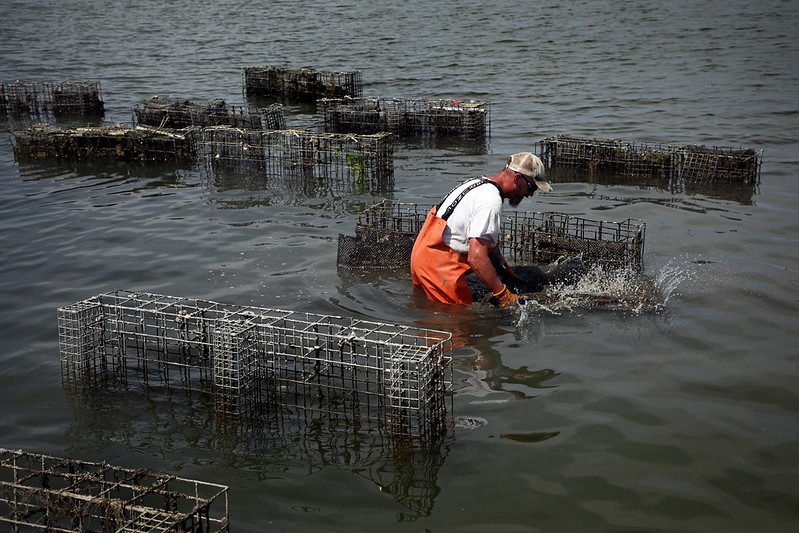
in addition to clam and oyster farming in the Chesapeake Bay and Atlantic Ocean, Virginia has inland aquacultural operations
Source: Virginia Sea Grant, Cherrystone Aqua-Farms

in addition to clam and oyster farming in the Chesapeake Bay and Atlantic Ocean, Virginia has inland aquacultural operations
Source: Virginia Sea Grant, Cherrystone Aqua-Farms
Growing corn and harvesting timber is land-based agriculture. Growing oysters, clams, trout, and tilapia under controlled conditions is water-based aquaculture.
Managing wild stocks of fish and shellfish is a form of natural resource management, separate from controlled aquaculture. Harvest of aquatic resources in the wild is one of the few commercial operations still based on the old "hunting and gathering" approach. The inventory of underwater resources is poorly understood, though scientific sampling of selected species does allow state and Federal agencies to establish commercial/recreational harvesting limits.
Estimating the number of fish in the Atlantic Ocean near Virginia, in the Chesapeake Bay, and in various rivers - and how populations of different species grow/diminish each year - is as much an art as it is science.
It is far easier to estimate how much corn, wheat, or soybeans are growing in individual fields. For longer-term management, foresters use photography, remote sensing, and sampling to calculate how many trees are present on a company's timberland, and how fast they are growing through drought years or good years. Trees don't move.
Aquatic resources such as fish are "here today - gone tomorrow." The obvious temptation for a waterman needing to make payments on a new boat is to estimate a large population, justifying a large harvest. Until dramatic declines in key species triggered Federal agencies to require more-scientific management, there was little incentive to count and conserve.
If the harvest of trees on private forestland is postponed, then the landowner can reap profits later. In contrast, waterman have few mechanisms to stockpile fish for harvest later. Since fish move around, any conservation by a Virginia waterman may benefit someone else in Virginia - or in Maryland, Delaware, North Carolina. It required interstate compacts, sponsored by the Federal government, to balance the costs of conservation with the benefits and to ensure fair opportunity for watermen in each state to get access to the natural resources.
Aquaculture overcomes that challenge by privatizing the resource. Virginia was a pioneer in leasing oyster and clam beds, now regulated by the Virginia Marine Resources Commission. A waterman who controls the right to harvest oysters/clams from "private rocks" (submerged lands leased from the state) can afford to wait until the shellfish are older and bigger. Such patience may lead to a higher return on investment, assuming disease, fresh water from a hurricane, or theft do not reduce the population first.
All Virginia aquaculture occurs in state waters, within three miles of the coast. There are no aquaculture operations in Federal waters off the Virginia coast. In the Pacific Ocean, the first Federal aquaculture lease was issued to the Catalina Sea Ranch off Huntington Beach, California. Its initial harvest of mussels was in 2018.1
Virginia's first step into private aquaculture was to offer leases for oyster gathering on particular spots in brackish waters. The state leased the bottom of rivers and the Chesapeake Bay so watermen could plant shells and grow oysters on "private rocks," where only the leaseholder was authorized to harvest. The Baylor surveys in 1892-94 identified places without natural oysters, and those areas were offered for aquaculture leases.
Watermen would gather young oysters and transfer them to their leases. Within about a year, the oysters would grow to a size sufficient for harvest:2
Overharvesting from the 1880's into the 1950's led to destruction of oyster reefs and a major decline in the annual harvest. In the 1960's two diseases, MSX and Dermo, reduced the wild oyster catch significantly. After Hurricane Agnes in 1972, government funding increased shell planting across the Chesapeake Bay but diseases continued to constrain the harvest. The Ballard family, which had started Cherrystone Aqua-Farms to farm oysters in 1895, shifted its focus to growing clams.
The salvation of oyster aquaculture in Virginia was the development by the Virginia Institute of Marine Science and the National Oceanic and Atmospheric Administration of a genetically-engineered "triploid" oyster that grew to harvest size before the diseases could kill it. Private hatcheries began to raise seed oysters as broodstock, and owners of oyster leases creating floating cages and bags where their aquaculture crops could be managed more intensively.3
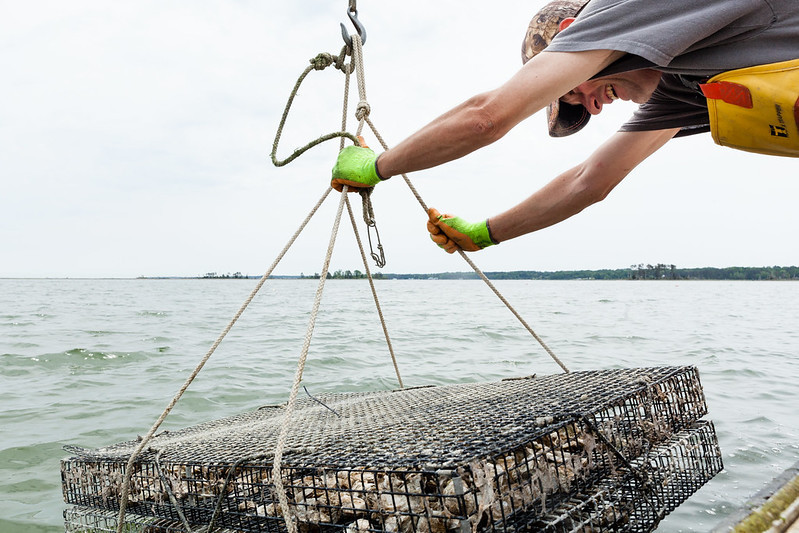
private aquaculture operations now rely primarily on oysters raised in cages, rather than on reefs at the bottom of rivers and the Chesapeake Bay
Source: Chesapeake Bay Program, Rappahannock River Oyster Company in Middlesex County, Va.
The other major form of aquaculture in Virginia is fish farming, especially trout and tilapia. Fish hatcheries offer the greatest amount of control, comparable to greenhouses for plants, though the biggest aquaculture business in Virginia is raising oysters in cages that float in open water. The Virginia Department of Wildlife Resources, a separate state agency distinct from the Virginia Marine Resources Commission and from the Department of Agriculture and Consumer Services, regulates the import of non-native fish into Virginia for aquaculture.
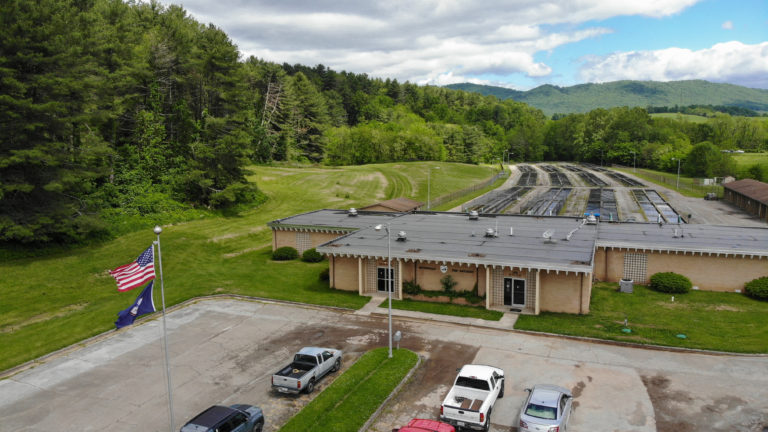
the Virginia Department of Wildlife Resources raises fish and stocks them in streams to support recreational fishing
Source: Virginia Department of Wildlife Resources, Wytheville Fish Hatchery
Virginia State University (VSU), one of the two land grant universities in the state, is the focal point for aquaculture research and Cooperative Extension outreach. A hatchery and various research and instruction ponds are located at VSU's Randolph Farm near Colonial Heights.
Private trout farms offer recreational fishing opportunities, and the Virginia Division of Wildlife Resources hatcheries raise coldwater and warmwater fish for stocking in state waters.
Warm-water aquaculture is successful in Virginia. It is possible to raise catfish and other species in outdoor ponds in Virginia, particularly in 4'x4' cages. However, Mississippi and other states further south have warmer temperatures; aquaculturalists further south generate more income from the greater productivity.
To block low-cost imports of catfish from Southeast Asia, the 2014 Farm Bill created a new requirement that the USDA Food Safety Inspection Service inspectors must be located at all facilities processing catfish for commercial sale. That was intended to increase costs in the United States, raising the opportunity to raise catfish in Virginia. As a side effect, the inspection requirement also reduced the potential for commercial-scale harvest to reduce the non-native blue catfish in the Chesapeake Bay tributaries.4
Indoor operations allow for careful control over temperature and water quality. The two largest fish farming facilities in Virginia are Blue Ridge Aquaculture in Henry County and Pure Salmon in Tazewell County.
Raising fish indoors, rather than in outdoor ponds, could be the future of commercial aquaculture for tilapia, catfish, and some other species. A spokesperson for the Global Aquaculture Alliance suggested that the fish farming industry will mimic the techniques used by the chicken and port producers to increase productivity substantially in the last 50 years:5
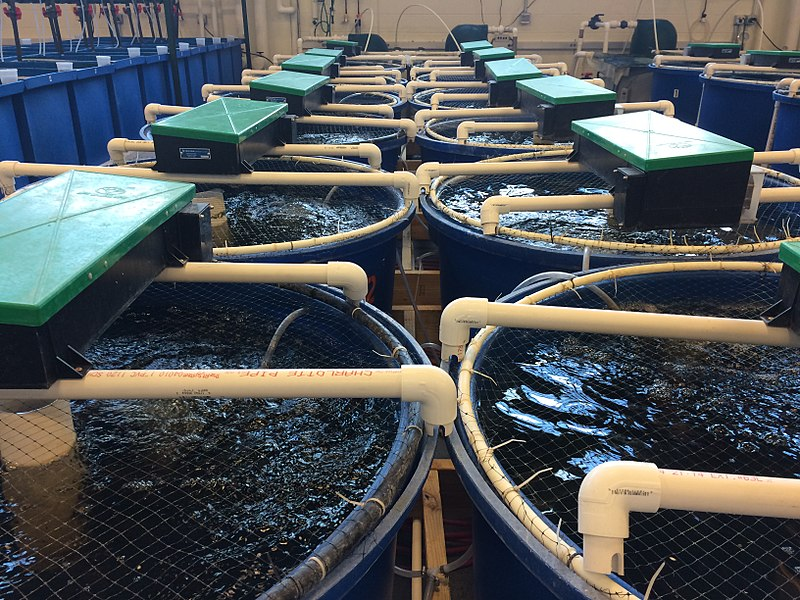
water is recirculated in a Virginia Tech Department of Food Science and Technology facility evaluating aquaculture technology
Source: Wikipedia, Recirculating aquaculture system
Not every aquaculture operation in Virginia has been successful. Virginia Cobia Farms, a joint project between Blue Ridge Aquaculture and a company in Maine, briefly raised cobia in a $600,000 aquaculture facility in Saltville. Cobia is a saltwater fish, but the company used a protein that triggered the natural capacity of that species of fish (Rachycentron canadum, also known as pompano) to grow in low-salinity water. Because cobia grows faster than salmon, the company's chairman said in 2007:6
Virginia Tech's Southwest Virginia Aquaculture Research Center, already doing research in Saltville on raising yellow perch, assisted the cobia aquaculture operation. The Saltville Industrial Authority leased a building to Virginia Cobia Farms for its indoor recirculating systems, and the Town of Saltville sold massive amounts of water to the operation.
Virginia Cobia Farms planned to invest $30 million and bought its building in 2010, but a deep economic recession cut demand for high-priced fish with name recognition far below salmon. Three years later the business closed. The building was transferred to the Saltville Industrial Development Authority in 2015.7
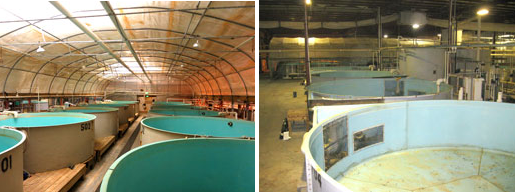
the Virginia Cobia Farms facilities in Saltville were advertised for sale at auction in 2014
Source: Woltz Brothers, Smyth County, Virginia - Industrial Property Auction
Some hatcheries seek to raise fish in aquaponics facilities, integrating the production of plants and fish. Blue Ridge Aquaculture has tried raising lettuce, tomatoes, and other vegetables using nutrient-enriched waters from its fish production operations. The company needs to remove wastes excreted by fish, and plants are a cost-effective way to clean the water in its Recirculating Aquaculture System.
The greenhouse at Virginia Highlands Community College in Abingdon has experimented with growing tilapia as a way to enhance the horticulture research and potentially create a new industry in the region where tobacco-based agriculture is declining. In 2014, Herb Aqua Farm started selling lettuce at the Williamsburg farmers market, after growing it in an aquaponics system in Smithfield.8
The 2018 Census of Aquaculture revealed that Virginia was #4 nationally in total aquaculture sales. Half of the value of those sales was from oysters. The 134 oyster farms in Virginia were 70% of all aquaculture operations in the state, which totaled 191 farms.9
A particularly ambitious proposal is to raise seafood in a laboratory. The Virginia Tech Future Foods Lab and Cellular Agriculture Initiative received a $3.2 million grant to develop zebrafish cell cultures that could be harvested without catching and killing any animals. The cells are raised in large vats and provided growth media for nutrients. The cells divide, and the plan is to harvest a percentage that is the equivalent of "crab from a lab", or "cod from a pod."
The Virginia Tech laboratory was located on the waterfront in Hampton, behind the NASA Langley Visitor Center. If raising the equivalent of seafood from cell cultures becomes successful, and enough customers are willing to purchase the "seafood" for the process to become cost-effective, then aquacultural operations could be expanded dramatically.8